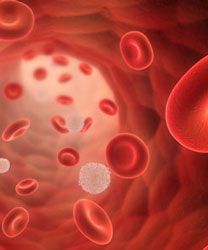Article
MRD, Genetic Classification Provide More Accurate Risk Stratification in Pediatric ALL
Author(s):
Investigators working in the UK and Europe found a correlation between minimal residual disease kinetics and risk for relapse in pediatric patients with acute lymphoblastic leukemia.
multiple myeloma

Investigators working in the UK and Europe found a correlation between minimal residual disease (MRD) kinetics and risk for relapse in pediatric patients with acute lymphoblastic leukemia (ALL).1
Risk for relapse correlated with MRD kinetics, and investigators found that each log reduction in disease level reduced the risk by 20% (hazard ratio [HR], 0.80; 95% CI, 0.77-0.83; P <.001).
Assigning patients to an MRD risk group based on a single threshold “does not reflect the response kinetics of the different genetic subtypes,” Anthony V. Moorman, MD, co-director, Leukaemia Research Cytogenetics Group, Northern Institute for Cancer Research, Newcastle University, and colleagues wrote in results published online in the Journal of Clinical Oncology.
“Currently, treatment protocols use a single MRD threshold to assign patients to risk groups, irrespective of the presence of genetic abnormalities; however, data generated by this study indicate that MRD must be interpreted within the context of genetics to maximize its effectiveness,” the investigators wrote. “Using different MRD cutoffs for different genetic subtypes allows more flexibility to define patient subgroups of the appropriate size and outcome. We propose that the future of stratification in ALL lies in the integration of MRD measurement with detailed genetic classification.”
A total of 3113 consecutive diagnosed with ALL by standard flow cytometric criteria and treated in the MRC UKALL2003 trial from 2003 to 2011 were included in this analysis. Patients classified as standard-risk (SR), defined as <10 years and white cell count <50 x 109/L, were assigned to a regimen A. High-risk (HR) patients, defined as ≥10 years and/or white cell count ≥50 x 109/L, were assigned to regimen B.
Patients with HR cytogenetics and those younger than 16 years with a slow early response, defined as ≥25% blasts in the day 15 marrow for SR patients or day 8 marrow for HR patients, were assigned to regimen C.
Regimen A consisted of vincristine, dexamethasone, and asparaginase followed by consolidation, CNS-directed therapy, interim maintenance delayed intensification, and continuing therapy. Patients assigned to regimen B also received daunorubicin during induction and Berlin Frankfurt Munster (BFM) consolidation. Patients in regimen C received an additional 4 doses of vincristine and two doses of pegylated asparaginase during BFM consolidation. Regimen C patients received escalating doses of intravenous methotrexate without folinic acid rescue, and vincristine and pegylated asparaginase as interim maintenance.2
MRD was evaluated by real-time quantitative polymerase chain reaction analysis of Ig/TCR gene rearrangements with a quantitative range of 0.01% as defined by the European MRD Study Group. Patients with undetectable MRD at end of induction (EOI; day 29) and before interim maintenance were classified as MRD low risk, as were those who had detectable EOI MRD (<0.01%), but undetectable MRD before the start of interim maintenance. MRD low-risk patients were eligible for treatment reduction random assignment. Patients with EOI MRD ≥0.01% were classified as MRD HR and were eligible for treatment intensification randomization.
Each log reduction in MRD equated to an approximate 20% decrease in the risk of an adverse event, according to univariable Cox proportional hazards regression models for event-free survival (EFS), relapse rate (RR), and overall survival (OS): EFS, 0.81 (95% CI, 0.78-0.83); RR, 0.80 (95% CI, 0.77-0.83); and OS, 0.77 (95% CI, 0.74-0.80).
The beneficial effect was consistent across treatment type, random assignment, and genetic subgroups, except for one/two delayed intensifications.
Investigators said that while risk for relapse was directly proportional to the MRD level within each genetic risk group, the absolute risk for relapse that was associated with a specific MRD level varied by genetic subtype.
Writing in an accompanying editorial, Stephen P. Hunger, MD, chief of the division of oncology and Director of the Center for Childhood Cancer Research, The Children’s Hospital of Philadelphia, noted that relying on MRD alone to risk stratify patients would combine patients with different RR, EFS, and OS rates into a single group and “genetic risk factors alone do not fully capture prognosis.”3
“Overall, this is an important study that provides new insights into the complex interplay between clinical risk factors, tumor genomics, and MRD that is linked to [risk for relapse] and outcome,” Hunger wrote. “These results challenge cooperative groups to use MRD in a more sophisticated way than the typically dichotomous definition of good or poor responders on the basis of one single threshold for all patients. To develop true precision medicine strategies for pediatric patients with ALL, we must accept this challenge and use integrated models in clinical trial design.”
References
- O’Connor D, Enshaei A, Bartram J, et al. Genotype-specific minimal residual disease interpretation improves stratification in pediatric acute lymphoblastic leukemia. J Clin Oncol [published online November 13, 2017]. doi: 0.1200/JCO.2017.74.0449.
- Vora A, Goulden N, Wade R. Treatment reduction for children and young adults with low-risk acute lymphoblastic leukaemia defined by minimal residual disease (UKALL 2003): a randomised controlled trial. Lancet Oncol. 2013;14(3):199-209. doi: 10.1016/S1470-2045(12)70600-9.
- Hunger SP. Integrated risk stratification using minimal residual disease and sentinel genetic alterations in pediatric acute lymphoblastic leukemia. J Clin Oncol [published online November 13, 2017]. doi: 10.1200/JCO.2017.76.0504.








